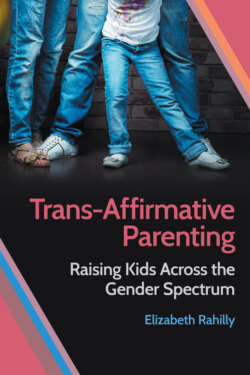Читать книгу Trans-Affirmative Parenting - Elizabeth Rahilly - Страница 14
На сайте Литреса книга снята с продажи.
Feminist Precursors
ОглавлениеIntensive, child-centered parenting is not the only historical development in child-rearing that has impacted the families I studied. Attentive to the complexities of gendered inequalities, many second-wave feminist scholars and activists called for child-rearing practices that resisted the stereotyping of male and female children, often referred to as “gender-neutral” or “feminist” parenting.53 Growing through the 1970s and 1980s, this brand of parenting included modeling egalitarian divisions of household labor, as well as permitting gender-inclusive toys, interests, and activities for young children. Feminist psychologist Sandra Bem, for example, one of the pioneers of such “gender-aschematic” parenting, as she termed it, often modified the characters in her children’s storybooks to undo gendered patterns (e.g., drawing breasts and long hair on a truck driver or a beard on an elementary schoolteacher).54 She also let her son wear barrettes and other stereotypically feminine items to school.55
However, Bem advised that she always tried to reduce the difference between boys and girls to anatomy when speaking to her children, ultimately reiterating a cisgender relationship between sex and gender: “A boy, we said again and again, is someone with a penis and testicles; a girl is someone with a vagina, a clitoris, and a uterus.”56 On these terms, gender-neutral parenting failed to rupture the quintessential link between sex and gender, even as parents tried to minimize the relevance of that link, effectively erasing childhood transgender possibilities. In fact, excerpts from other practitioners of this genre at the time seem stunningly transphobic and homophobic.57 In short, in its original formulations, gender-neutral parenting encouraged boys and girls to pursue whatever interests they wanted, regardless of stereotypes—but they were ever and always cisgender boys and girls, respectively, and ideally heterosexual.
More recent feminist sociologists have exposed the “stalled revolution” of these parenting ideals, which they largely attribute to lingering, negative associations between childhood gender nonconformity and adult homosexuality. Sociologist Karin Martin, for example, reviewed a variety of parenting guides published through the end of the twentieth century and found that gender-neutral parenting was still not wholeheartedly endorsed due to fears over encouraging homosexuality.58 Martin concluded that “the gendered socialization of children seems only to have mildly waned since the height of the second wave.… There may well be rich research territory in the area of gender socialization that has been abandoned by many feminist researchers.”59 Similarly, sociologist Emily Kane found that even the most gender-progressive parents will succumb to the “gender trap,” or social expectations that limit parents’ best intentions against traditional gender norms.60 This was especially true in the cases of male children and “icons of femininity,” such as frilly skirts and dresses and Barbie dolls—parents drew the line at these.61 Indeed, few, if any, of the parents in Kane’s research seemed cognizant of the prospect of a transgender child. As one particularly gender-inclusive mother said, “ ‘Eli, you’ll never be a girl, but if you want that Barbie pool you can have it.’ ”62 Evidently, as conventionally conceived and practiced, gender-neutral parenting has remained ignorant of, or perhaps resistant to, transgender possibilities. For all its limitations, however, this legacy has enabled a baseline level of openness to children’s gender-atypical preferences among contemporary parents, which I discuss in chapter 1.
